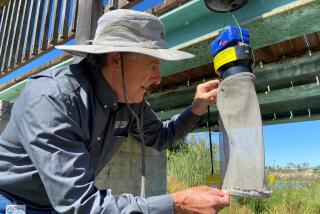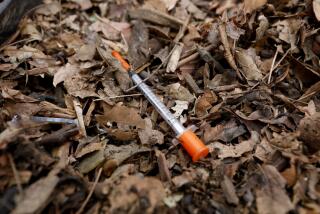Orange County and AIDS
- Share via
Ten years ago it seemed to touch only gays. Now it threatens everyone. From infants and women to heterosexual men, more Orange County residents are being afflicted by acquired immune deficiency syndrome. Recent county statistics bear some good news: The rate of infection among gay men has declined, drugs are helping patients survive longer, and although the need for services to patients remains great, the county’s network of resources and AIDS researchers continues to expand. How O.C. Compares Orange County’s AIDS case rate in 1991, 1.9 per 10,000 population, placed it between the statewide and nationwide figures. Laguna Beach had the highest incidence of new reported AIDS cases in the county, 22.2. That rate was much higher even than those of San Francisco, New York and Los Angeles. Orange County: 1.9 California: 2.5 United States: 1.7 Laguna Beach: 22.2 San Francisco: 12.3 New York: 8.2 Los Angeles: 2.9 Laguna Beach: 22.2 Laguna Niguel: 4.4 Costa Mesa: 3.7 Dana Point: 3.4 Newport Beach: 3.3 Santa Ana: 2.2 San Clemente: 2.1 Westminster: 1.9 Huntington Beach: 1.9 Irvine: 1.8 Orange: 1.8 Garden Grove: 1.7 Laguna Hills: 1.7 Fountain Valley: 1.7 Cypress: 1.6 Mission Viejo: 1.6 Villa Park: 1.6 Seal Beach: 1.6 Anaheim: 1.6 San Juan Capistrano: 1.5 Tustin: 1.5 Fullerton: 1.4 Stanton: 1.3 Brea: 1.2 Los Alamitos: 0.8 La Palma: 0.6 Lake Forest: 0.5 Yorba Linda: 0.4 Buena Park: 0.3 Unincorporated areas: 0.2 Placentia: 0.2 La Habra: 0.2 Death Toll Climbing The cumulative AIDS death tool of county residents and those receiving diagnoses here increased precipitously during the 1980s. Projections for the rest of this decade indicate no abatement, with the total near 7,000 by the year 2000. 1984: 52 1999: 6,461 Note: Projected figures based on data through December, 1990 Celebrities Make HIV Testing Skyrocket When a prominent individual or celebrity dies or in some other fashion is touched by the AIDS virus, it sets off a run of testing for the disease. Here’s the pattern from the county’s alternative test site, where the bulk of AIDS tests here are conducted: 1985 * October, 1985: Rock Hudson dies 1987 * February, 1987: Liberace dies * June, 1987: Paul Gann announces illness 1991 * November, 1991: Magic Johnson announces HIV-positive status 1992 * April, 1992: Arthur Ashe announces he has AIDS Who’s Chiefly Affected In 1991, the vast majority of AIDS cases reported involved homosexual or bisexual men. This follows the cumulative pattern of reported cases in the county. Minority homosexual / bisexual men: 15.7% IV drug users: 7.9% Hetrosexuals: 3.4% Transfusion: 2.3% Hemophiliacs: 1.1% Unknown: 5.3% Perinatal (mother-to-fetus): 0.2% White homosexual / bisexual men: 64% * May not add up to 100% due to rounding. Thirtysomethings Hit Hardest AIDS is no respecter of age, but most of the cases reported in the county during 1991 occurred among those between the ages of 30 and 49. 13-19: 0.4% Under 13: 0.2% 60-69: 4.5% 50-59: 9.1% 40-49: 21.1% 30-39: 46.8% 20-29: 17.7% High-Risk Groups: Cases Down The rate which homosexual / bisexual men and intravenous drug users test positive for the AIDS virus is declinging. Among homosexual / bisexual men, the rate per 100 cases tested at the county’s Santa Ana clinic dropped about 70%; among intravenous drug users, 50% Minority Concerns While minorities in Orange County are not disportionately affected by AIDS, reported cases among Latinos have risen dramatically, from 11% of the total to 20% in four years. Concerned that the trend may foreshadow the experience of other cities with heavy infection rates among minorities, public and private agencies are targeting education messages to the Latino community. This year, there have been 48 reported cases among Latino men as of April 30. Male Latino reported cases 1983: 4 ‘84: 2 ‘85: 11 ‘86: 11 ‘87: 17 ‘88: 31 ‘89: 46 ‘90: 48 ‘91: 94 Female Findings Since the first two cases appeared in 1984, the number of women with AIDS has risen steadily in Orange County. The first cases were transfusion-associated; now they are divided evenly among transfusions, intravenous drug users and heterosexuals whose partners use drugs. This year, as of April 30, there have been 17 cases reported among women. Reported cases 1984: 2 ‘85: 1 ‘86: 4 ‘87: 8 ‘88: 17 ‘89: 18 ‘90: 14 ‘91: 28 The Culprit * HIV: The human immuodeficiency virus, which destroys the immune system, leaving the body vulnerable to infections and probable death. Means of Infection * This virus is transmitted by blood, vaginal discharge or semen (usually through sexual intercourse), intravenous drug use, breast milk or from a woman to her unborn child. Stages of Disease * Asymptomatic HIV (infected but not ill): Those infected with HIV, such as Magic Johnson, may show no symptoms of the disease for 10 to 12 years but can still infect others. About 15,000 Orange County residents now carry this virus. * Symptomatic HIV: Person is infected with HIV (HIV-positive) and has symptoms of infection / diminishing immune system, such as swollen lymph glands, weight loss, night sweats, frequent diarrhea. About 2, 600 county residents are in this stage. * AIDS: Person is not only HIV-positive but also is severely ill with pneumonia, cancers and possibly other life-threatening infections. People with AIDS now live a median of 18 months after diagnosis. By early March, 2,047 county residents have had AIDS since the disease was first detected here in 1981. Preventing Infection * Abstain from sex * Have intercourse with only one partner * Use latex condoms * Do not share needles * Do not have sex with intravenous drug users Also: * You cannot catch AIDS from hugging, kissing or sneezing. * You cannot catch AIDS from swimming pools, toilet seats, drinking fountains, handshakes, food or a mosquito bite. * No vaccine or cure for AIDS is in sight, although medicines such as AZT (Zidovudine) prolong life for those who are ill. Local Research Dr. Jeremiah G. Tilles, 60, is the head of UC Irvine’s infectious diseases department and this year directs $843, 733 of research into AIDS education for health professionals and new treatments for acquired immune deficiency syndrome. He and other UCI faculty members use microscopic samples of the human immunodeficiency virus to test the antiviral action of experimental drugs.
Tilles is one of many UCI researchers studying AIDS from many angles. For example: Dr. Christy Sanborg is studying the origin of cell abnormalities in AIDS.
Dr. Sudhir Gupta directs basic research into the structure of the AIDS virus.
Prof. Ross F. Conner is developing educational materials aimed at Latino migrant workers. One, a fotonovella, a comic-book-style pamphlet popular in Mexico, explains why men should wear condoms during sex. AIDS Resources / Who to Contact Orange County Health Care Agency: Education, outreach to Latinos and other minorities, testing and early treatment at its clinic at 1725 W. 17th St. Santa Ana. In Santa Ana, (714) 834-8129 in English, (714) 834-8700 in Spanish. American Red Cross, Orange County Chapter: AIDS education in English and Spanish for health professionals, schools, corporations and the public. Certifies AIDS instructors. Offers pamphlets, videos and posters. In Santa Ana, (714) 835-5381. AIDS Services Foundation: Offers counseling, home health care, food, emergency cash, other support for men, women and children with AIDS or symptomatic HIV infection. In Irvine, (714) 852-1010. AIDS Response Program: Education and support for gay and bisexual men and for college students of both sexes. In Garden Grove, at Gay and lesbian Center, (714) 534-0961. Orange County Center for Health: Funded in part by national Centers for Disease Control. Offers education, testing, counseling for AIDS patients, mostly Latino clients. In Anaheim, (714) 956-1900. Children’s Hospital of Orange County: Operates KIDS (Kids’ Immune Deficiency Sydrome) Center, Orange County’s only state-approved clinic offering screening for suspected HIV-infected children as well as ongoing care. I Orange, (714) 532-8761 or (714) 532-8888. Women’s Voices: Orange County’s only support group for women infected with HIV. Volunteers are building an archive of women’s history with AIDS. In Laguna Beach, at the Healing Center, (714) 494-7547. Laguna Shanti: Sometimes gives non-traditional therapy to HIV clients, their families and friends with support groups, writing and watercolor classes, plus therapy through photography. In Laguna Beach, (714) 494-1446. Pathways of Orange County: Support groups and employment program for those with life-threatening illness. In Costa Mesa, (714)966-5138. Sources: Orange County Health Care Agency; AIDS Services Foundation of Orange County; Centers for Disease Control; American Red Cross Researched by DANNY SULLIVAN, LANIE JONES and LYNN SMITH / Los Angeles Times
More to Read
Sign up for Essential California
The most important California stories and recommendations in your inbox every morning.
You may occasionally receive promotional content from the Los Angeles Times.













